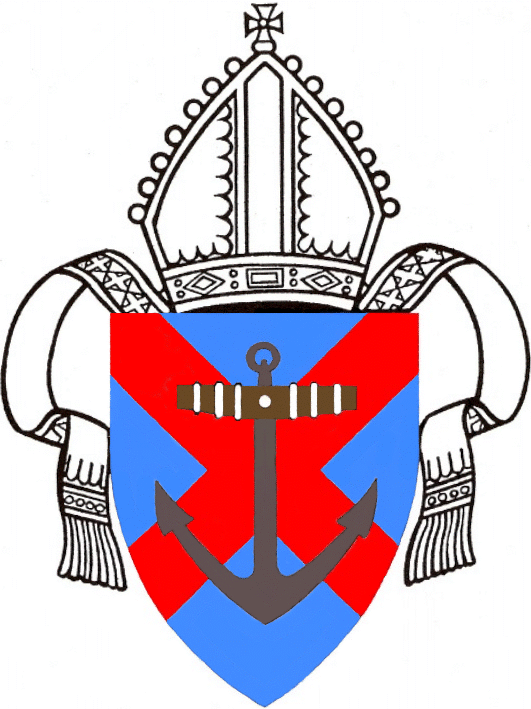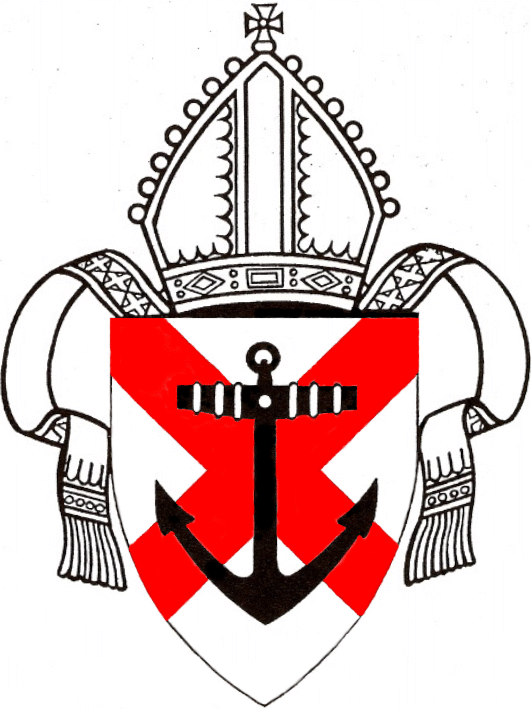DIOCESE OF GRAHAMSTOWN (Anglican)
Diocese established in 1853, a division of the Diocese of Cape Town.
Cathedral: St George, Grahamstown (until 1883).
Bishop’s residence: Bishopstowe, Grahamstown.
variant
Arms taken into use in 1853, and probably in use until 1886. The blazon reads:
Argent, a saltire Gules, over all an anchor Anchor Sable.
Brownell writes: “The saltire, or ‘St Andrew’s Cross’, in this early version of the arms, commemorates the founding of the Diocese, with that of Natal, on St Andrew’s Day 1853.
“It is, however, in the colours of the cross of St George to whom the Cathedral was then dedicated.
“The anchor links the arms to those of the Metropolitan See.”
He notes further: “These arms, which were borne by the Diocese of Grahamstown at least until the end of Nathaniel Merriman’s episcopacy in 1882, were adopted by the Diocese of Mashonaland on its establishment in 1891.”
A footnote referring to the frontispiece of Pauline Whibley’s book Merriman of Grahamstown states: “The portrait of Nathaniel James Merriman, 3rd Bishop of Grahamstown, shows the Bishop’s arms impaled by those of the Diocese.”
About the diocese:
The dioceses of Grahamstown and Natal were the first subdivisions of the immense Diocese of Cape Town.
Both these dioceses were to know controversy in their early years, that of Grahamstown perhaps less damagingly than that of Natal. Brownell writes:
“During the unfortunate term of office of Dr F H Williams as Dean of the then Cathedral of St George in Grahamstown, he effectively banned both Bishops Merriman and Webb from the Cathedral Church. This led Bishop Webb to establish the Pro-Cathedral of St Michael.

“After Dean Williams died it was possible for peace to be restored between the factions and the greatly improved and enlarged cathedral was consecrated under the name of St George and St Michael on All Saints’ Day (1 November) 1893.
“The sequence of these two names was later reversed to the more customary St Michael and St George.”
Variant of the 1853 arms:
Brownell notes an early variant
of the arms shown above which may be blazoned:
Azure, a saltire Gules, over all an anchor proper.
He writes further: “The blue field in this version of the Diocesan arms is similar to that of the old See of St Andrews and, no doubt, was intended to allude to the founding of the Diocese on St Andrew’s Day 1853.
“The saltire is, however, in the colour of the cross of St George to whom the Cathedral was then dedicated. The red saltire on a blue field contravenes the heraldic colour rule that tincture should not be placed upon tincture nor metal on metal.
“This example of ‘false heraldry’ though apparently not widely used by the Diocese of Grahamstown, has nevertheless been perpetuated, without the anchor (but ensigned of a mitre) in the arms of the Old Andrean Club and St Andrew’s College, Grahamstown, which were registered under the (South African) Protection of Names Uniforms and Badges Act, 1935.
“The reason for alternating metal and colour in heraldry is a sound one, since it ensures contrast and facilitates easy identification.”
Note that in this version the anchor is proper – that is to say, it has a wooden stock, while the rest of it is metallic.
Bishops: The first Bishop of Grahamstown was John Armstrong. He was succeeded in office by H Cotterill (1856), Nathaniel Merriman (1871) and Allan Becher Webb (1883). Bishop Webb was in office when the current arms of the diocese were adopted in 1886.



